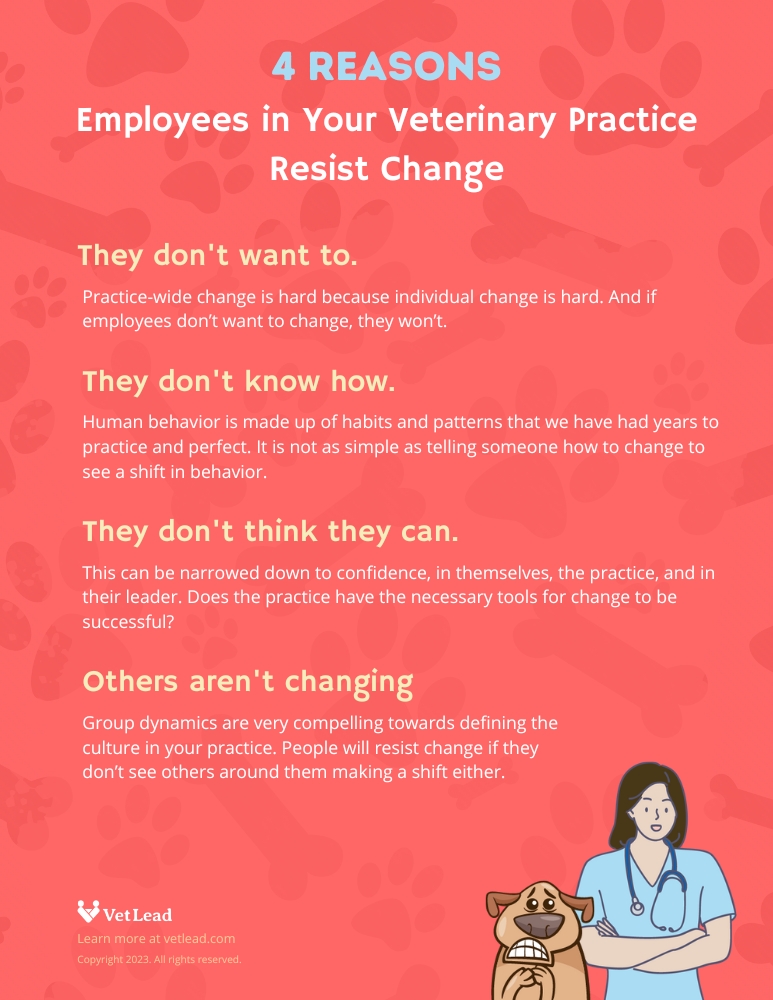Check our the recording of our latest live event, Navigating Difficult Conversations.
There is a common theme that we see in veterinary practices today. Change. Change is hard and always happening. Often we change too much and too fast. We don’t leave time for one change to stick before we mix it up again. Sound familiar?
Change Can Feel Never-Ending in A Veterinary Practice
Many team members in your practice are concerned with the rate of change. They often feel like change is never ending. They feel they can’t keep up with the pace. Often, your team feels the change burnout because we leaders forget to be the change we want to see. Instead, we get caught up in creating new policies and procedures.
We implement new and improved forms or we change meeting times to magically increase their effectiveness. We do all of this in an effort to increase compliance with the new task. Unfortunately, no amount of new processes or additional meetings will ever compensate for what truly needs to be different. Bottom line: we need to change the way we lead change in our practice.
Why People Resist Change
To effectively cause change, we need to understand why people resist change in the first place. Then, we need to ensure we are equipped with the capability and a plan to lead the team through the change. What are the reasons people resist change?
There are four reasons and they all have to do with human behavior:
1
They Don't Want to Change
Practice-wide change is hard because individual change is hard. And if employees don’t want to change, they won’t.
The first step is to define the change for your team. Connect them to both the vision behind the desired change and their individual goals. In order to align your team toward a vision, it has to be collaborative. That means you cannot define the vision alone. It has to be clear and compelling enough for people to want to follow it.
The Veterinary Leadership Program
Set Yourself Up for Success
Get info on this exclusive program.
Learn how to:
- 1Build an accountable team
- 2Make change happen
- 3Improve performance
- 4Hire exceptional talent
And much more!
2
They Don't Know How to Change
Human behavior is made up of habits and patterns that we have had years to practice and perfect. It is not as simple as telling someone how to change to see a shift in behavior. True behavior change takes time, commitment, coaching, and practice.
It is critical that the behavior of your leaders (including you) align with the desired behavior change to model for the rest of the practice. For example, a manager may say she wants candid discussions from the staff. However, if she berates the messenger when she gets bad news, she will not get honesty. Ever. No matter how many times she asks for it.
3
They Don't Think They Can Change
This can be narrowed down to confidence, in themselves, the practice, and in their leader. Does the practice have the necessary tools for change to be successful?
Do employees believe leadership will stick with the change and see it through? Does the staff have the capabilities to correctly implement the change? These types of doubts often cause people to shy away from trying something new.
4
Others Around Them Aren’t Changing
Group dynamics are very compelling towards defining the culture in your practice. People will resist change if they don’t see others around them making a shift either. There is a lot of risk in going first!
If you can get enough momentum for change by involving people from the start, setting a clear vision, and committing to the change yourself, then people are much more likely to follow. Once change begins, it becomes about support and growing as a team through the change process.

Want these 4 reasons to go?
Share it with leaders and teams. No email address required.
Lead Differently
Only after understanding the reasons team members resist change, can leaders make the choice to lead differently. In the past, it was probably okay to lead change with verbal and written instruction and new policies. But we don’t live in that place anymore.
Employees must adapt to make faster decisions, innovate, and implement new technology. In this kind of world, change is more complex. It requires a commitment, not just compliance to last beyond next month’s staff meeting.
When a leader chooses to lead through influence, they gain the momentum and commitment to sustain change. Influence allows practice leaders to take a change-fatigued team past the point of resistance. They can move their team past task compliance…all the way to commitment.
What do you think? Let us know in the comments section below.

